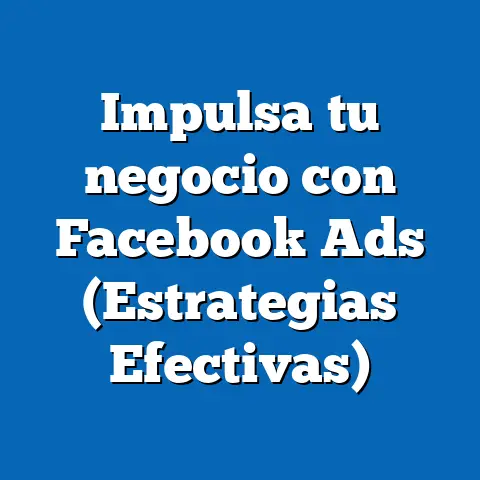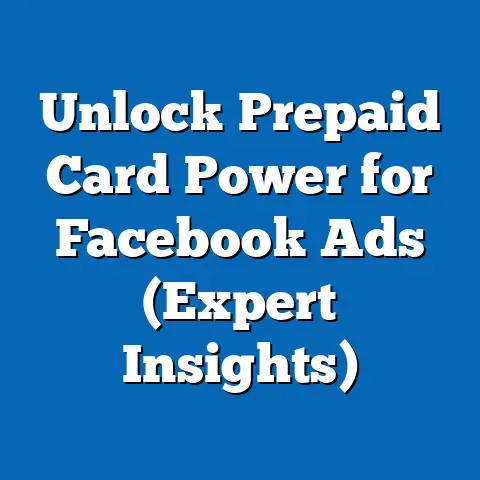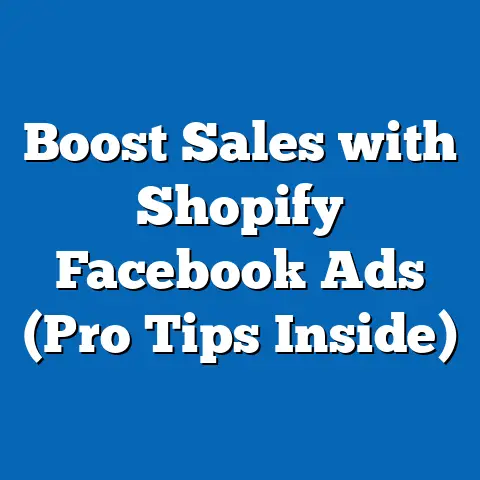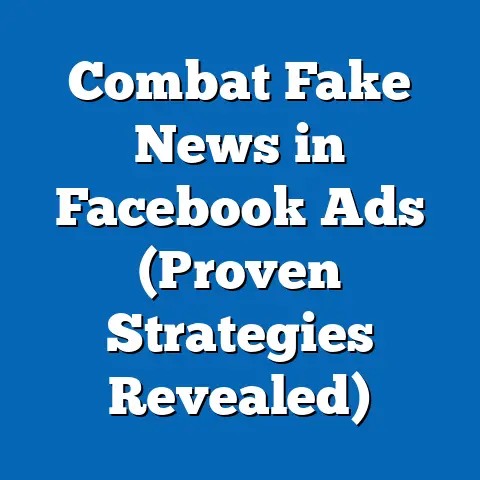Maximize Facebook Sidebar Ads for Greater Impact (Pro Tips)
The digital advertising world is a crowded space, a constant battle for attention. We’re bombarded with ads everywhere we look – in our newsfeeds, on websites, even in our email inboxes. With so much noise, it’s easy for your message to get lost in the shuffle. That’s why savvy marketers are always looking for new ways to cut through the clutter and connect with their target audience.
Facebook, with its billions of users, remains a powerhouse for reaching potential customers. But simply throwing money at Facebook ads isn’t enough. You need a strategic approach, one that leverages the unique features and formats the platform offers. One such format, often overlooked but incredibly powerful, is the Facebook sidebar ad.
Sidebar ads might seem like a relic in the age of mobile-first marketing, but they still hold significant value, especially when targeted correctly and crafted with compelling content. In this article, I’ll show you how to unlock the full potential of Facebook sidebar ads, providing actionable tips and pro strategies to maximize your impact and drive real results.
And because we’re living in a time where environmental consciousness is no longer a niche concern, but a mainstream value, I’ll also be weaving in how to align your sidebar ad campaigns with climate awareness and sustainability. This isn’t just about doing good; it’s about tapping into a growing market of eco-conscious consumers who are actively seeking out brands that share their values.
Whether you’re a seasoned digital marketer or just starting out, this guide will equip you with the knowledge and tools you need to create Facebook sidebar ads that not only grab attention but also deliver a meaningful message that resonates with your target audience and contributes to a more sustainable future. Let’s dive in!
Understanding Facebook Sidebar Ads
So, what exactly are Facebook sidebar ads? They’re the ads that appear in the right-hand column of the Facebook desktop site. While they might seem less prominent than news feed ads, which are integrated directly into the user’s stream of content, sidebar ads offer some distinct advantages.
First, let’s talk about visibility. While users might scroll past news feed ads without a second glance, sidebar ads remain visible as users browse. This constant presence can lead to increased brand awareness and recognition over time.
Second, sidebar ads are less intrusive than news feed ads. They don’t interrupt the user’s experience in the same way, which can make them more receptive to your message. Think of it as a gentle reminder, rather than a forceful interruption.
Third, sidebar ads can be highly effective for certain types of businesses and campaigns. They’re particularly well-suited for driving traffic to your website, generating leads, or promoting specific products or services. For example, a local restaurant could use a sidebar ad to promote a daily lunch special, or an online retailer could showcase a featured product.
But who exactly is the target audience for sidebar ads? Generally, desktop users tend to be older and more affluent than mobile users. They’re also more likely to be engaged in tasks that require a larger screen, such as research, work, or online shopping. This makes sidebar ads a great option for targeting professionals, homeowners, or anyone who spends a significant amount of time on their computer.
Now, let’s talk about businesses that can benefit from sidebar ads. I’ve found that they work particularly well for:
- Local businesses: Sidebar ads are a great way to reach customers in your local area, especially if you offer a service that requires a physical location, such as a restaurant, salon, or doctor’s office.
- E-commerce businesses: Sidebar ads can be used to promote specific products or collections, driving traffic to your online store and generating sales.
- B2B companies: Sidebar ads can be used to generate leads for your business, offering valuable content such as ebooks, webinars, or white papers in exchange for contact information.
- Events: Promoting local events can be boosted by sidebar ads, especially if your target audience is desktop users.
Takeaway: Facebook sidebar ads offer a unique opportunity to reach a specific audience with a less intrusive ad format. By understanding their strengths and limitations, you can leverage them to achieve your marketing goals.
Crafting Compelling Ad Copy
Okay, you’ve decided to give sidebar ads a try. Now what? The first step is crafting ad copy that grabs attention and compels users to click. Remember, you only have a few seconds to make an impression, so your words need to be concise, impactful, and relevant to your target audience.
Let’s start with the headline. This is the first thing people will see, so it needs to be attention-grabbing. Here are a few tips for writing effective headlines:
- Use strong verbs: Words like “discover,” “learn,” and “get” are more engaging than passive verbs like “is” or “are.”
- Highlight benefits: Focus on what the user will gain by clicking on your ad, such as “Discover the Secret to a Greener Home” or “Learn How to Save Money with Solar Power.”
- Create urgency: Use phrases like “limited time offer” or “act now” to encourage immediate action.
- Ask a question: Questions can pique curiosity and encourage users to click to find the answer. For example, “Want to Reduce Your Carbon Footprint?”
Now, let’s talk about the body copy. This is where you can provide more details about your offer and explain why users should click on your ad. Here are a few tips for writing effective body copy:
- Be concise: Keep your copy short and to the point, focusing on the most important information.
- Highlight key features: Emphasize the unique benefits of your product or service, such as its eco-friendliness, durability, or affordability.
- Tell a story: Stories are a powerful way to connect with your audience on an emotional level. Share a story about how your product or service has helped someone else, or about your company’s commitment to sustainability.
- Use social proof: Include testimonials, reviews, or case studies to build trust and credibility.
And finally, let’s talk about calls-to-action (CTAs). This is the final nudge that encourages users to take the next step. Here are a few tips for writing effective CTAs:
- Be clear and specific: Tell users exactly what you want them to do, such as “Learn More,” “Shop Now,” or “Get a Free Quote.”
- Create urgency: Use phrases like “limited time offer” or “act now” to encourage immediate action.
- Make it visually appealing: Use a button or other visual element to make your CTA stand out.
Now, let’s look at some examples of effective ad copy that highlights eco-friendly products or services:
- Headline: “Go Green with Our Sustainable Cleaning Products” Body Copy: “Our plant-based cleaning products are tough on dirt and grime, but gentle on the environment. Shop now and get 20% off your first order!” CTA: “Shop Now”
- Headline: “Reduce Your Carbon Footprint with Solar Panels” Body Copy: “Solar panels are a clean, renewable energy source that can save you money on your electricity bill. Get a free quote today!” CTA: “Get a Free Quote”
- Headline: “Support Sustainable Agriculture with Our Organic Produce” Body Copy: “We source our produce from local, organic farms that use sustainable farming practices. Shop now and taste the difference!” CTA: “Shop Now”
Takeaway: Compelling ad copy is essential for capturing attention and driving engagement with your Facebook sidebar ads. By focusing on concise, impactful headlines, benefit-driven body copy, and clear calls-to-action, you can create ads that resonate with your target audience and encourage them to take the next step.
Visual Elements that Stand Out
While compelling ad copy is crucial, don’t underestimate the power of visuals. In fact, studies have shown that ads with images are more likely to be clicked on than ads without images. That’s because visuals are processed much faster than text, allowing you to grab attention and convey your message in a matter of seconds.
So, how do you choose visuals that stand out and effectively communicate your message? Here are a few tips:
- Choose high-quality images: Avoid blurry, pixelated, or poorly lit images. Use professional-grade photos or illustrations that are visually appealing and relevant to your offer.
- Use images that reflect your brand: Your visuals should be consistent with your brand’s overall aesthetic and messaging. Use your brand colors, fonts, and style to create a cohesive look and feel.
- Showcase your product or service: If you’re promoting a specific product or service, make sure it’s prominently featured in your visual. Use close-up shots, lifestyle photos, or videos to showcase its features and benefits.
- Use images that evoke emotion: Emotionally resonant images can be incredibly powerful in capturing attention and connecting with your audience. Use images that convey feelings of happiness, excitement, or inspiration.
- Optimize for mobile: Remember that many people will be seeing your sidebar ads on smaller screens, so make sure your visuals are optimized for mobile viewing. Use clear, concise images that are easy to see and understand.
When it comes to visuals that reflect a brand’s commitment to sustainability, here are a few ideas:
- Showcase eco-friendly products: Use images that highlight the sustainable materials, manufacturing processes, or packaging of your products.
- Feature nature scenes: Images of lush forests, pristine beaches, or vibrant wildlife can evoke a sense of environmental responsibility.
- Highlight sustainable practices: Use images that show your company’s commitment to sustainable practices, such as recycling, energy conservation, or waste reduction.
- Feature happy customers: Images of satisfied customers using your eco-friendly products or services can build trust and credibility.
Here are some design principles that can help you create visually appealing ads:
- Use a clear and concise layout: Avoid cluttering your ad with too many elements. Use a simple, clean layout that is easy to understand and navigate.
- Use a limited color palette: Choose a few colors that complement each other and reflect your brand’s aesthetic. Avoid using too many colors, as this can be overwhelming and distracting.
- Use legible fonts: Choose fonts that are easy to read and that complement your brand’s overall style. Avoid using fonts that are too small, too fancy, or too difficult to read.
- Use white space effectively: White space (or negative space) is the empty space around your ad’s elements. Use white space to create visual balance and to make your ad more appealing.
Takeaway: Visual elements are a critical component of effective Facebook sidebar ads. By choosing high-quality images, reflecting your brand’s commitment to sustainability, and applying sound design principles, you can create ads that grab attention, convey your message, and drive results.
Targeting the Right Audience
You can have the most compelling ad copy and stunning visuals in the world, but if you’re not targeting the right audience, your efforts will be wasted. That’s why audience targeting is such a critical component of any successful Facebook advertising campaign.
Facebook offers a wide range of targeting options that allow you to reach specific demographics, interests, and behaviors. Here are a few of the most important targeting options to consider:
- Demographics: Target users based on their age, gender, location, education, income, and other demographic factors.
- Interests: Target users based on their interests, hobbies, and passions. This is a great way to reach people who are already interested in your product or service.
- Behaviors: Target users based on their online behavior, such as their purchase history, website visits, or app usage. This is a great way to reach people who are likely to be interested in your offer.
- Custom Audiences: Create custom audiences based on your existing customer data, such as email lists, website visitors, or app users. This is a great way to re-engage with past customers and build brand loyalty.
- Lookalike Audiences: Create lookalike audiences based on your custom audiences. This is a great way to reach new potential customers who share similar characteristics with your existing customers.
When targeting eco-conscious demographics, here are a few interests and behaviors to consider:
- Interests: Sustainable living, organic products, renewable energy, climate activism, environmental conservation, veganism, vegetarianism.
- Behaviors: Purchase of eco-friendly products, donations to environmental organizations, participation in environmental events, engagement with environmental content online.
Here are some tips on creating custom audiences based on interests related to sustainability:
- Upload your email list of customers who have purchased eco-friendly products from your store.
- Create a website custom audience of users who have visited pages on your website related to sustainability.
- Create an app custom audience of users who have downloaded your app related to environmental conservation.
Here are some insights on using lookalike audiences to reach new potential customers who align with climate-specific values:
- Create a lookalike audience based on your customer list of eco-conscious consumers.
- Create a lookalike audience based on your website visitors who have visited your sustainability-related pages.
- Create a lookalike audience based on your app users who have engaged with your environmental content.
Takeaway: Targeting the right audience is essential for maximizing the effectiveness of your Facebook sidebar ads. By leveraging Facebook’s targeting options and focusing on eco-conscious demographics, you can reach the people who are most likely to be interested in your offer and contribute to a more sustainable future.
Analyzing and Optimizing Ad Performance
You’ve crafted compelling ad copy, chosen stunning visuals, and targeted the right audience. Now it’s time to track your results and optimize your campaigns for maximum performance.
Data analytics is crucial for measuring the effectiveness of your Facebook sidebar ads. By monitoring key performance indicators (KPIs), you can gain insights into what’s working and what’s not, and make adjustments accordingly.
Here are some of the most important KPIs to monitor:
- Impressions: The number of times your ad was shown to users.
- Reach: The number of unique users who saw your ad.
- Click-Through Rate (CTR): The percentage of users who clicked on your ad after seeing it.
- Conversion Rate: The percentage of users who completed a desired action after clicking on your ad, such as making a purchase, filling out a form, or downloading a file.
- Cost Per Click (CPC): The average cost you paid for each click on your ad.
- Cost Per Conversion (CPC): The average cost you paid for each conversion.
- Engagement Metrics: Likes, comments, shares, and other interactions with your ad.
A/B testing is a powerful technique for optimizing your Facebook sidebar ads. By testing different ad variations, you can determine what resonates best with your target audience and improve your overall performance.
Here are a few things you can A/B test:
- Headlines: Test different headlines to see which ones generate the most clicks.
- Body copy: Test different body copy to see which ones are most persuasive.
- Visuals: Test different images and videos to see which ones are most engaging.
- Calls-to-action: Test different CTAs to see which ones drive the most conversions.
- Targeting: Test different targeting options to see which ones reach the most relevant audience.
When conducting A/B tests, make sure to only change one variable at a time. This will allow you to accurately measure the impact of each change and determine what’s working best.
Here are some tips on using customer insights to refine future ad campaigns focusing on climate-friendly initiatives:
- Survey your customers to understand their motivations for choosing eco-friendly products.
- Analyze customer reviews and feedback to identify areas for improvement in your products or services.
- Track customer engagement with your sustainability-related content to see what resonates best with them.
- Use customer data to create more targeted and personalized ad campaigns.
Takeaway: Analyzing and optimizing your ad performance is essential for maximizing your ROI. By monitoring key performance indicators, conducting A/B tests, and leveraging customer insights, you can continually refine your Facebook sidebar ads and achieve your marketing goals.
Case Studies and Success Stories
Let’s take a look at some real-world examples of brands that have successfully utilized Facebook sidebar ads to promote their eco-friendly products and services.
Case Study 1: A Local Organic Farm
A local organic farm used Facebook sidebar ads to promote their weekly CSA (Community Supported Agriculture) program. They targeted users in their local area who had expressed an interest in organic food, sustainable agriculture, and healthy living.
Their ad copy highlighted the benefits of joining their CSA program, such as access to fresh, locally grown produce, support for sustainable farming practices, and a connection to the local community.
Their visuals featured images of their farm, their farmers, and their happy customers enjoying their produce.
As a result of their Facebook sidebar ads, they saw a significant increase in sign-ups for their CSA program and a greater awareness of their farm within the local community.
Case Study 2: An Eco-Friendly Cleaning Product Company
An eco-friendly cleaning product company used Facebook sidebar ads to promote their line of plant-based cleaning products. They targeted users who had expressed an interest in sustainable living, green cleaning, and non-toxic products.
Their ad copy highlighted the fact that their products were made with natural ingredients, were safe for families and pets, and were effective at cleaning.
Their visuals featured images of their products, their ingredients, and their happy customers using their products in their homes.
As a result of their Facebook sidebar ads, they saw a significant increase in sales of their cleaning products and a greater awareness of their brand among eco-conscious consumers.
Lessons Learned:
- Target the right audience: Make sure to target users who are already interested in your product or service and who align with your brand’s values.
- Highlight the benefits: Focus on the benefits of your product or service, such as its eco-friendliness, durability, or affordability.
- Use compelling visuals: Use high-quality images and videos that showcase your product or service and that evoke emotion.
- Track your results: Monitor your KPIs and make adjustments to your campaigns as needed.
Takeaway: By studying successful case studies and learning from their experiences, you can gain valuable insights into how to effectively utilize Facebook sidebar ads to promote your eco-friendly products and services.
Conclusion
Facebook sidebar ads, while often overlooked, can be a powerful tool for reaching your target audience and achieving your marketing goals. By crafting compelling ad copy, choosing stunning visuals, targeting the right audience, and analyzing and optimizing your ad performance, you can maximize the impact of your campaigns and drive real results.
But in today’s world, it’s not enough to simply sell products or services. Consumers are increasingly demanding that brands align with their values, including their commitment to sustainability. By incorporating climate-conscious messaging into your Facebook sidebar ads, you can not only attract new customers but also contribute to a more sustainable future.
Remember, every small step counts. By making conscious choices about your advertising strategies, you can make a positive impact on the environment and inspire others to do the same.
So, go forth and implement the pro tips provided in this article. Create Facebook sidebar ads that not only grab attention but also deliver a meaningful message that resonates with your target audience and contributes to a more sustainable future. The world will thank you for it.





